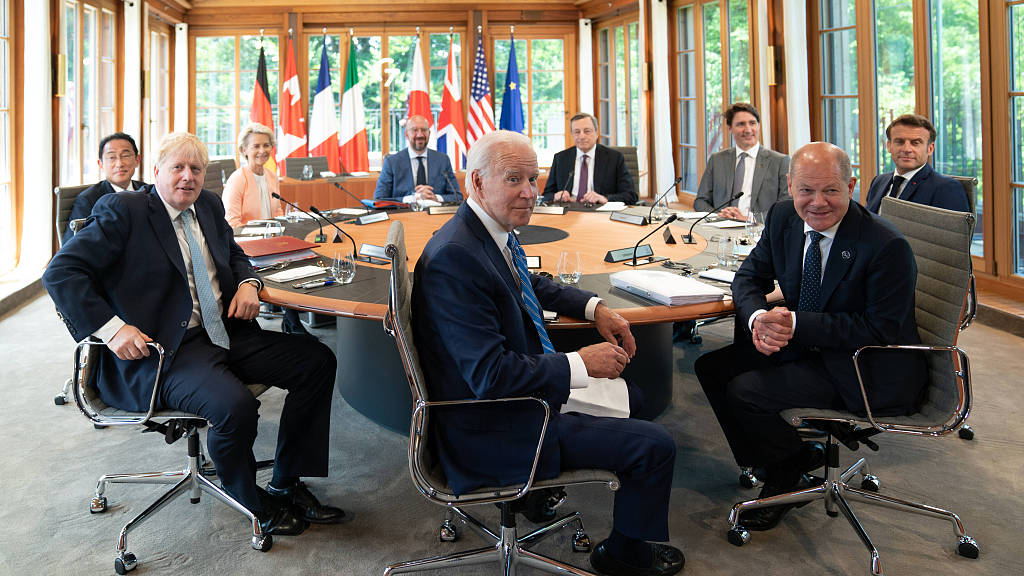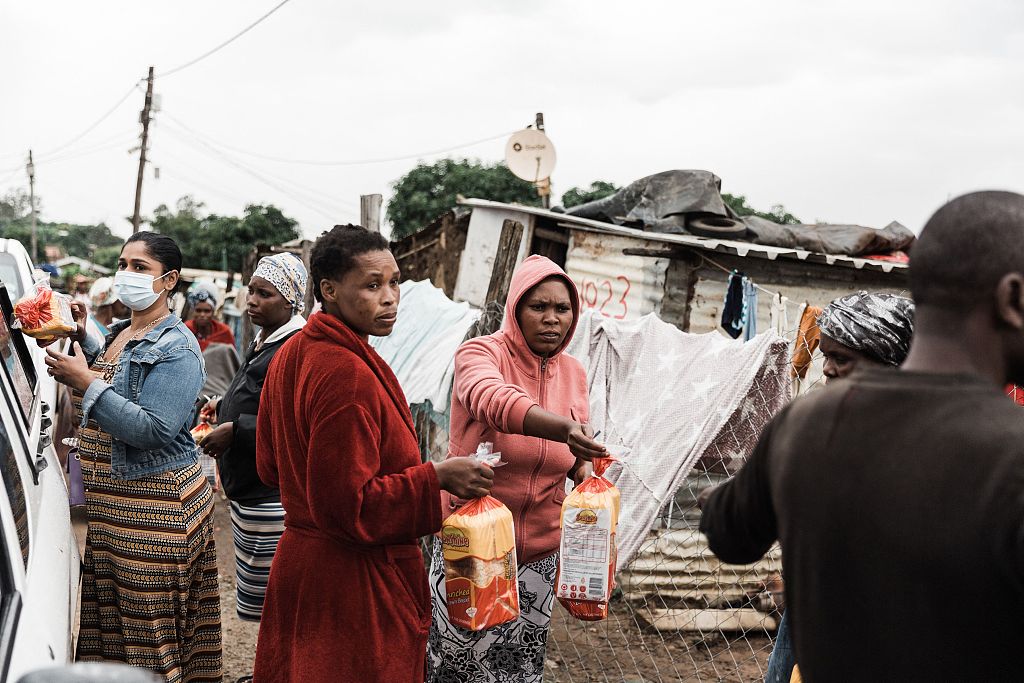
Clockwise from left, Fumio Kishida (covered), Prime Minister of Japan, Ursula von der Leyen, President of the European Commission, Charles Michel, President of the European Council, Mario Draghi, Prime Minister of Italy, Justin Trudeau, Prime Minister of Canada, Emmanuel Macron, Prime Minister of France, German Chancellor Olaf Scholz, U.S. President Joe Biden and Boris Johnson, Prime Minister of the United Kingdom sit at the first working session in Castle Elmau in Kruen, near Garmisch-Partenkirchen, Germany, June 26, 2022. /VCG
Clockwise from left, Fumio Kishida (covered), Prime Minister of Japan, Ursula von der Leyen, President of the European Commission, Charles Michel, President of the European Council, Mario Draghi, Prime Minister of Italy, Justin Trudeau, Prime Minister of Canada, Emmanuel Macron, Prime Minister of France, German Chancellor Olaf Scholz, U.S. President Joe Biden and Boris Johnson, Prime Minister of the United Kingdom sit at the first working session in Castle Elmau in Kruen, near Garmisch-Partenkirchen, Germany, June 26, 2022. /VCG
Editor's note: Thomas W. Pauken II is the author of "U.S. vs China: From Trade War to Reciprocal Deal," and a consultant on Asia-Pacific affairs and geopolitical commentator. The article reflects the author's opinions and not necessarily the views of CGTN.
As the group of seven (G7) leaders gathered for a summit in Schlauss Elmau in southern Germany over the weekend, United States President Joe Biden announced that the G7 pledged around $600 billion to help build infrastructure projects for developing nations across the globe. In other words, it's the Belt and Road Initiative (BRI) with non-Chinese characteristics.
The win-win partnerships of BRI served as an amazing economic booster model for the world and Chinese companies could go global with the it as the baseline.
Accordingly, we should not be surprised that the Western powers wish to imitate the BRI with their own copycat version dubbed "Partnership for Global Infrastructure and Investment (PGII)." But let's be honest, PGII looks already set to fail. The name is boring too.
Biden announced a similar plan last year called Build Back Better World, but it died as a legislative bill on the U.S. Senate floor and deservedly so. Apparently, Biden re-wrapped this global initiative with backing from other European countries. Washington pledges $200 billion. and European leaders would put up another 300 billion euros.
But where will the funds come from?
"I want to be clear. This isn't aid or charity. It's an investment that will deliver returns for everyone," media reports quote Biden as saying. He added that it would allow countries to "see the concrete benefits of partnering with democracies."
The U.S. president said hundreds of billions of additional dollars would come from multilateral development banks, development finance institutions, sovereign wealth funds and others. Nonetheless, the initial funding from the U.S. side looks to be coming from charity projects, including the U.S. Agency for International Development donating $50 million to the World Bank's Childcare Incentive Fund.
But outside of government subsidies, where's the other money coming from? And can sovereign governments of the developing nations avoid real and terrifying debt traps? If PGII is not charity, the money handed to the developing nations would come either in the form of loans or investments. Hence, if defaults happen, the poor people from the emerging markets would bear the tough consequences.
Thus far, Biden highlighted flagship projects such as building a $2 billion solar plant in Angola, commissioned by the U.S. Commerce Department with direct financing from the U.S. Export-Import Bank, U.S.-based firm AfricaGlobal Schaffer and the U.S. project developer Sun Africa. Another $3.3 million was handed over to the Institut Pasteur in Senegal to mass produce vaccines.
Bad timing with global economic downturn
The G7 leaders are ignoring the perils of the current economic climate by engaging in very expensive and time-consuming infrastructure projects, while making onerous demands on the same developing nations they claim to be helping. According to Politico:
"The partnership will also provide a structure for the G7 nations to combine their resources in offering emerging economies cash to turn off their coal plants. The first of these so-called Just Energy Transition Partnerships is being rolled out in South Africa — others are under discussion in India, Indonesia, Vietnam and Senegal. German Chancellor Olaf Scholz said Sunday that Berlin's contribution to South Africa would amount to 300 million euro."
The Biden administration is asking these countries to shut down their coal plants amid the rising onerous threats of global food and energy shortages that will hit developing nations the hardest.

Volunteers from the Phoenix Crisis Center hand out loaves of bread and canned food to those in need of food in Bhambayi township following heavy rains, mudslides and winds north of Durban, South Africa, April 13, 2022. /VCG
Volunteers from the Phoenix Crisis Center hand out loaves of bread and canned food to those in need of food in Bhambayi township following heavy rains, mudslides and winds north of Durban, South Africa, April 13, 2022. /VCG
Meanwhile, one should wonder if the $600 billion pledged can be better spent elsewhere. G7 member states are struggling mightily from high inflationary pressures and severe supply chain disruptions. More and more families in wealthy nations are going homeless. Just visit any American city and you will find huge enclaves of people living in tents, as well as sleeping on benches and in public parks.
The PGII does not even highlight the building of new roads or bridges. According to media reports, Biden said the U.S would greenlight projects in low- and middle-income countries that help tackle climate change, along with upgrading global health, gender equity and digital infrastructure.
Washington appears to be using the PGII to indoctrinate developing nations into supporting their political, ideological and foreign policy objectives rather than to generate greater profits for global investors. So, it's doubtful the U.S.-led initiative can continue running six months later on.
Empty promises from a broken West
We should anticipate the Biden administration is doing nothing more than making empty promises here. The PGII looks like nothing more than a wild fantasy that will soon vanish when it's time for the G7 leaders to transfer the hard currency over to the listed recipient nations.
The global economy is headed for hard times and the PGII will not change the current global trends for the better. The $600 billion on hand is needed for more urgent projects in the short-term outlook, such as boosting domestic energy capacity and raising agricultural production levels in the countries of North America and Western Europe, as well as in Japan.
The PGII is so expensive that Western powers can't afford it right now and for the next few years ahead. Besides, China has already proven they can do it better, since the BRI has become an economic development booster for developing nations. The U.S. is just acting silly thinking that they can out-rival China with the announcement of a $600 billion vanity project that's unlikely to succeed in the first place.
(If you want to contribute and have specific expertise, please contact us at opinions@cgtn.com. Follow @thouse_opinions on Twitter to discover the latest commentaries on CGTN Opinion Section.)

